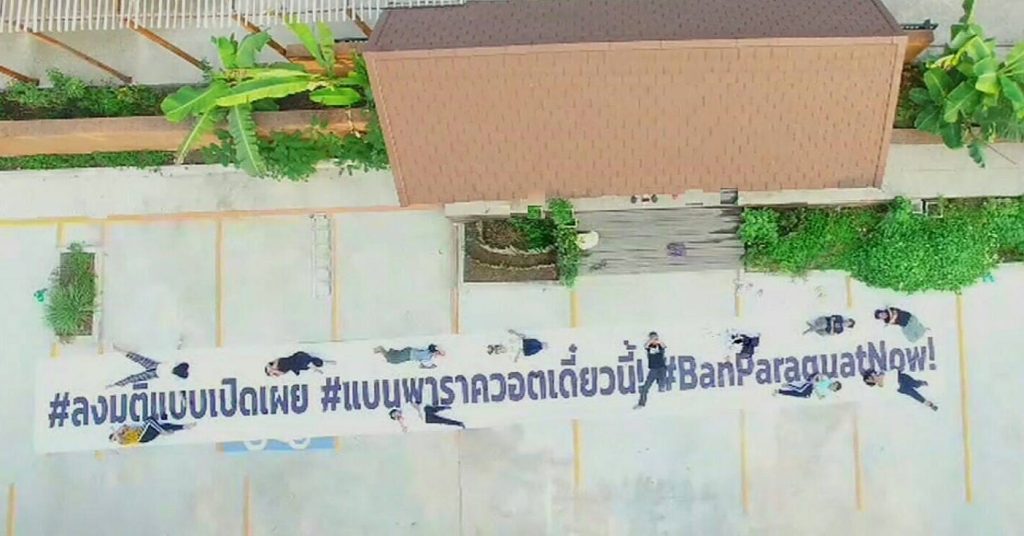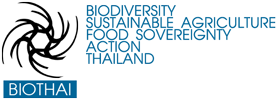
Paraquat – a highly toxic herbicide that is banned for use in 53 countries, including Switzerland, its country of origin, and China, the world’s largest manufacturer of paraquat.
Chlorpyrifos – has been linked to developmental delays in infants and young children. Residues of this insecticide have been found in a wide variety of fruit and vegetables produced in Thailand.
Glyphosate – the herbicide imported in the largest quantities in Thailand, has been identified as a likely carcinogen based on a review of the evidence by the International Agency for Research on Cancer.
5 June 2018
700 organisations petition Mr Krisada Boonraj, the Minister for Agriculture and Cooperatives, on behalf of the Thai Prime Minister, to ban the use of hazardous agricultural chemicals in Thailand. https://biothai.org/node/1441
23 May 2018
The Advisory Committee of the Hazardous Substances Control Bureau met to consider banning and restricting the use of hazardous substances on – allows the registration of paraquat and chlorpyrifos in Thailand. https://biothai.org/node/1439
December 2017
Hazardous Substances Control Bureau announced that its decision [on whether or not to ban paraquat and chlorpyrifos and to impose restrictions on the use of glyphosate] would be completed within three months.
November 2017
Mr. Chatchai Sarikalya, the Minister General, and Mr. Suwit Chaikiattiyos, Director-General of the Department of Agriculture granted permission to the agri-giant company Syngenta to re-register paraquat. Subsequently, other companies have been permitted to register products containing both paraquat and chlorpyrifos.
19 Sept 2017
People came out onto the streets in 50 provinces all around Thailand, calling on the Prime Minister and provincial governors to take a stand on banning paraquat
5 April 2017
The Ministry of Public Health convened a Task Force on the Use of High-Risk Agricultural Chemicals. After a review of the evidence, Dr. Piyasakol Sakolsatayadorn, Minister of Public Health recommended to ban the use of paraquat and chlorpyrifos at the end of December 2019. The Minister also recommended regulatory measures on glyphosate to prohibit its use in areas near water springs, forests, public spaces, waterways, water sources, and communities – especially near schools, daycare centers, and hospitals. https://biothai.org/node/1431
7 October 2016
Thai PAN published the results of their second round of testing on chemical pesticide residues for 2016, finding that just over half the samples of fruit and vegetables that were tested contained chemical pesticide residues. https://biothai.org/node/1436
20 March 2015
The International Agency for Research on Cancer (IARC), of the World Health Organization (WHO), designated glyphosate as “probably carcinogenic to humans” after a review of the existing evidence. http://www.iarc.fr/en/media-centre/iarcnews/pdf/MonographVolume112.pdf
Reference information about paraquat, chlorpyrifos, and glyphosate
Baharuddin MRB, Sahid IB, Noor MABM, Sulaiman N et. al. Pesticide risk assessment: A study on inhalation and dermal exposure to 2,4-D and paraquat among Malaysian paddy farmers. Journal of Environmental Science and Health 46:7, 2011.
Callahan CI, Hamad LA, Olson JR, Ismail AA et. al. Longitudinal assessment of occupational determinants of chlorpyrifos exposure in adolescent pesticide workers in Egypt. International Journal of Hygiene and Environmental Health 220, 2017.
Gawarammana IB, Buckley NA. Medical management of paraquat ingestion. British Journal of Clinical Pharmacology 72:5, 2011.
Hertzman C, Wiens M, Bowering D, Snow B et. al. Parkinson’s disease: A case-control study of occupational and environmental risk factors. American Journal of Industrial Medicine 17:3, 1990.
Lee WJ, Blair A, Hoppin JA, Lubin JH, et. al. Cancer Incidence among Pesticide Applicators Exposed to Chlorpyrifos in the Agricultural Health Study. Journal of the National Cancer Institute 96:23, 2004.
Myers JP, Antoniou MN, Blumberg B, Carroll L et. al. Concerns over use of glyphosate-based herbicides and risks associated with exposures: a consensus statement. Environmental Health 15:19, 2016.
Parvez S, Gerona RR, Proctor C, Friesen M, et. al. Glyphosate exposure in pregnancy and shortened gestational length: a prospective Indiana birth cohort study. Environmental Health 17:23, 2018.
Silver MK, Shao J, Zhu B, Chen M et. al. Prenatal naled and chlorpyrifos exposure is associated with deficits in infant motor function in a cohort of Chinese infants. Environment International 106, 2017.
Viswanath G, Chatterjee S, Dabral S, Nanguneri SR et. al. Anti-androgenic endocrine disrupting activities of chlorpyrifos and piperophos. The Journal of Steroid Biochemistry and Molecular Biology 120:1, 2010.
Hazardous Substances Act (in Thai): http://www.diw.go.th/hawk/law/haz/2535-krisdika.pdf
